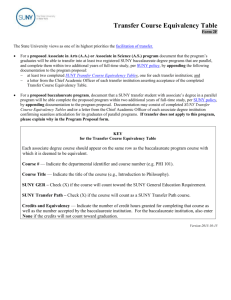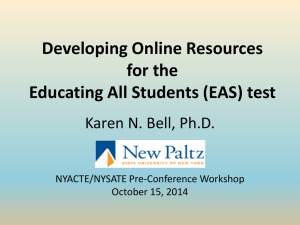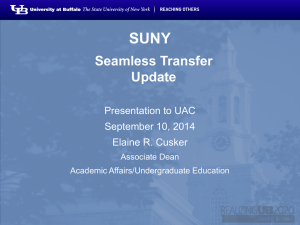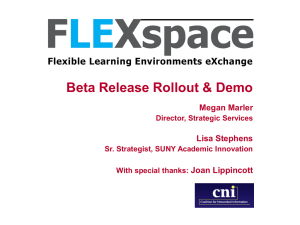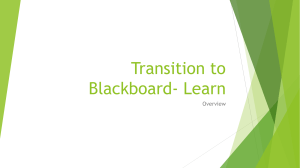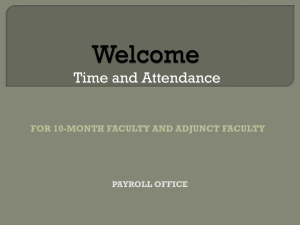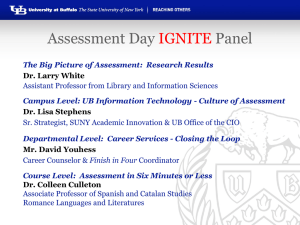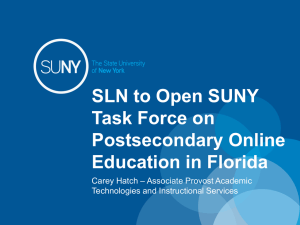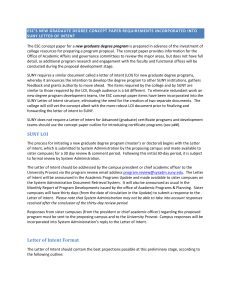New Curriculum Proposal - Suffolk County Community College
advertisement
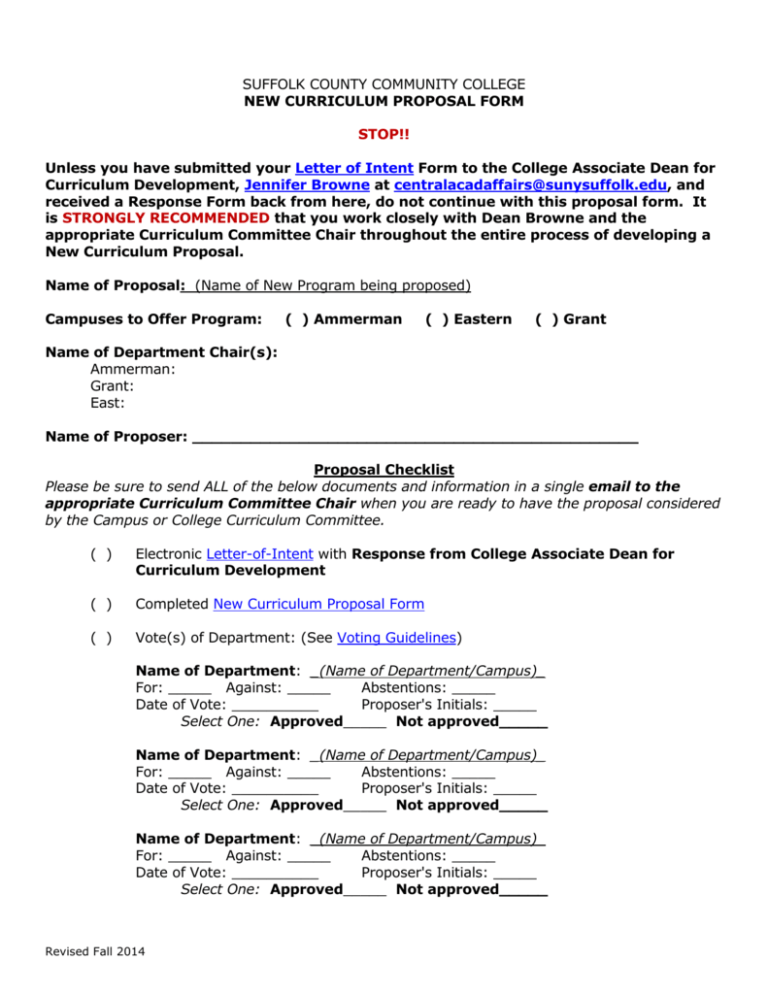
SUFFOLK COUNTY COMMUNITY COLLEGE NEW CURRICULUM PROPOSAL FORM STOP!! Unless you have submitted your Letter of Intent Form to the College Associate Dean for Curriculum Development, Jennifer Browne at centralacadaffairs@sunysuffolk.edu, and received a Response Form back from here, do not continue with this proposal form. It is STRONGLY RECOMMENDED that you work closely with Dean Browne and the appropriate Curriculum Committee Chair throughout the entire process of developing a New Curriculum Proposal. Name of Proposal: (Name of New Program being proposed) Campuses to Offer Program: ( ) Ammerman ( ) Eastern ( ) Grant Name of Department Chair(s): Ammerman: Grant: East: Name of Proposer: ______________________________________________ Proposal Checklist Please be sure to send ALL of the below documents and information in a single email to the appropriate Curriculum Committee Chair when you are ready to have the proposal considered by the Campus or College Curriculum Committee. ( ) Electronic Letter-of-Intent with Response from College Associate Dean for Curriculum Development ( ) Completed New Curriculum Proposal Form ( ) Vote(s) of Department: (See Voting Guidelines) Name of Department: _(Name of Department/Campus)_ For: _____ Against: _____ Abstentions: _____ Date of Vote: __________ Proposer's Initials: _____ Select One: Approved_____ Not approved_____ Name of Department: _(Name of Department/Campus)_ For: _____ Against: _____ Abstentions: _____ Date of Vote: __________ Proposer's Initials: _____ Select One: Approved_____ Not approved_____ Name of Department: _(Name of Department/Campus)_ For: _____ Against: _____ Abstentions: _____ Date of Vote: __________ Proposer's Initials: _____ Select One: Approved_____ Not approved_____ Revised Fall 2014 ( ) Course Proposal Forms for all new courses and revised courses and course syllabi for existing courses that are new to the program. List Courses Here: ( ) ( ) Course descriptions for existing courses (exclucing SUNY General Education courses) to be included in new program SCCC Program Assessment Plan ( ) SCCC Curriculum Map ( ) For A.A./A.S. Program Proposal: Two Transfer Equivalency Tables with two letter from Chief Academic Officers from two separate SUNY baccalaureate institutions stating acceptance of the transfer equivalency table. ( ) Other forms as necessary for program approval (e.g. Distance Education Form) ( ) Executive Dean's Acknowledgment of Support Form(s) cc: Jennifer Browne, Associate Dean for Curriculum Development Tina Good, College Curriculum Committee Chair Executive Deans of affected campuses Revised Fall 2014 SUFFOLK COUNTY COMMUNITY COLLEGE NEW CURRICULUM PROPOSAL FORM Name of Proposal: (Name of New Program being proposed) Campuses to Offer Program: I. ( ) Ammerman ( ) Eastern ( ) Grant PROGRAM FORMAT: Check all SED-defined format, mode and other program features that apply to the entire program. A. Format(s): [ ]Day [ ]Evening [ ]Not Full-Time B. Modes: [ ]Standard [ ]Weekend [ ]Accelerated [ ]Evening/Weekend [ ]Distance Education NOTE: If the program is designed to enable students to complete 50% or more of the course requirements through distance education, check Distance Education. You will need to append a Distance Education Format Proposal. II. PROGRAM DESCRIPTION, PURPOSES AND PLANNING A. What is the description of the program as it will appear in the catalog? (Give the exact description you wish to see in the catalog for this program. Assume the description on this form will be copied and pasted directly into the catalog, Banner, and all other places where program descriptions are referenced.) B. What are the program’s educational and, if appropriate, career objectives, and the program’s primary student learning outcomes (SLOs)? NOTE: SLOs are defined by the Middle States Commission on Higher Education in the Characteristics of Excellence in Higher Education as “clearly articulated written statements, expressed in observable terms, of key learning outcomes: the knowledge, skills and competencies that students are expected to exhibit upon completion of the program.” C. How does the program relate to the College's and SUNY's mission and strategic goals and priorities? What is the program’s importance to the institution, its relationship to existing and/or projected programs and its expected impact on them? As applicable, how does the program reflect diversity and/or international perspectives? D. How were faculty involved in the program’s design? Describe input by external partners, if any (e.g., employers and institutions offering further education? E. How did input, if any, from external partners (e.g., educational institutions and employers) or standards influence the program’s design? If the program is designed Revised Fall 2014 to meet specialized accreditation or other external standards, such as the educational requirements in Commissioner’s Regulations for the profession, append a side-byside chart to show how the program’s components meet those external standards. If SED’s Office of the Professions requires a specialized form for the profession to which the proposed program leads, append a completed form at the end of this document. F. Enter anticipated enrollments for Years 1 through 5 in the table below. How were they determined, and what assumptions were used? What contingencies exist if anticipated enrollments are not achieved? Year 1 2 3 4 5 G. Anticipated Headcount Enrollment Full-time Part-time Total Estimated FTE Program Impact on SUNY and New York State 1. Need: What is the need for the proposed program in terms of the clientele it will serve and the educational and/or economic needs of the area and New York State? How was need determined? Why are similar programs, if any, not meeting the need? 2. Employment: For A.A.S. program proposals, use the table below to list potential employers of graduates that have requested establishment of the program and state their specific number of positions needed. If letters from employers support the program, they may be appended at the end of this form. Need: Projected positions Employer In initial year In fifth year 3. Similar Programs: Use the table below to list similar programs at other institutions, public and independent, in the service area, region and state, as appropriate. Expand the table as needed. NOTE: Detailed program-level information for SUNY institutions is available in the Academic Program Enterprise System (APES) or Academic Program Dashboards. For non-SUNY programs, program titles and degree information – but no enrollment data – is available from SED’s Inventory of Registered Programs. Institution 4. Revised Fall 2014 Program Title Degree Enrollment Collaboration: Did this program’s design benefit from consultation with other SUNY campuses? If so, what was that consultation and its result? III. Admissions IV. A. Remembering, that SCCC is an open-admissions institution, does this program have specific admissions requirements? If so, describe those admissions standards and explain why this program cannot be consistent with the College’s open-access mission? B. If there are specific admissions requirements beyond the College’s open-access mission, describe the process for evaluating exceptions to those requirements? C. Describe how the College will encourage enrollment in this program by persons from groups historically underrepresented in the College, discipline or occupation? Academic and Other Support Services (Summarize the academic advising and support services available to help students succeed in the program.) V. Prior Learning Assessment If this program will grant credit based on Prior Learning Assessment, describe the methods of evaluating the learning and the maximum number of credits allowed, or check here [ ] if not applicable. VI. Program Assessment and Improvement Describe how this program’s achievement of its objectives will be assessed, including the date of the program’s initial assessment and the length (in years) of the assessment cycle. Complete the SCCC Program Learning Outcomes Assessment Plan and attach to this document. Complete the SCCC Curriculum Map for the proposed program. VII. Sample Program Schedule and Curriculum NOTES: The Program Schedule and Curriculum must show all curricular requirements and demonstrate that the program conforms to SUNY’s and SED’s policies. It must show how a student can complete all program requirements within SUNY credit limits, unless a waiver has been granted: two years of full-time study (or the equivalent) and 64 credits for an associate degree. It must show how students in A.A., A.S. programs can complete, within the first two years of full-time study (or 60 credits), no fewer than 30 credits in SUNY-approved general education courses, with at least 3 credits each in Basic Communication and Mathematics, plus no fewer than three credits each in at least 5 of the following 8 categories: Natural Science, Social Science, American History, Western Civilization, Other World Civilizations, Humanities, the Arts and Foreign Languages. It must show how students can complete Liberal Arts and Sciences (LAS) credits appropriate for the degree. When a SUNY Transfer Path applies to the program, it must show how students can complete the number of SUNY Transfer Path (TPath) courses shown in the SUNY Transfer Paths within the first two years of full-time study (or 60 credits). Special Cases for the Sample Program Schedules: For a program with multiple tracks or with multiple schedule options (such as full-time and part-time options), use one Program Schedule for each track or schedule option. Note that licensure qualifying and non-licensure qualifying options cannot be tracks; they must be separate programs. When this form is used for a multi-award and/or multi-institution program that is not based entirely on existing programs, use the schedule to show how a sample student can complete the proposed program. Revised Fall 2014 A. Will the program be offered through a nontraditional schedule (i.e., not on a semester calendar), what is the schedule and how does it impact financial aid eligibility? Yes_____ No_____ NOTE: Consult with your campus financial aid administrator for information about nontraditional schedules and financial aid eligibility. B. For each existing course that is part of the proposed program (including cognates and restricted electives, but not including general education), append a catalog description at the end of this proposal. C. Complete a New Course Proposal Form for each new course in the program. Complete a Course Revision Proposal Form for each course revision proposed for this program. D. Does the program require external instruction, such as clinical or field experience, agency placement, an internship, fieldwork, or cooperative education? Yes_____ No_____ If Yes, append a completed External Instruction form at the end of this document. Revised Fall 2014 Sample Program Schedule a) Has the proposed program received a SUNY program-level waiver? ( ) Yes ( ) No If waiver has been received, attach waiver to this proposal.. Name of SUNY Transfer Path, if one exists: _______________________________________ b) Use the table to show how a typical student may progress through the program; copy/expand the table as needed. Complete all columns that apply to a course. See KEY. Fall 1: Cr GER LAS Maj TPath Course Number & Title Co/Prerequisit es GER Course Number & Title Term credit totals: Course Number & Title TPath LAS Maj Co/Prerequisites New See KEY. Term 4: Co/Prerequisit es GER Course Number & Title Term credit totals: Program Totals (in credits): Cr Term credit totals: See KEY. Cr GER LAS Maj TPath New Fall 3: See KEY. Spring 2: New Cr TPath LAS Maj Co/Prerequisites New Term credit totals: Total Credits: SUNY GER: LAS: Major: Elective & Other: Number of SUNY GER Categories: KEY Cr: credits GER: SUNY General Education Requirement (Enter Category Abbreviation) LAS: Liberal Arts & Sciences (Enter credits) Maj: Major requirement (Enter credits) TPath: SUNY Transfer Path Courses (Enter credits) New: new course (Enter X) Co/Prerequisite(s): list co/prerequisite(s) for the noted courses Upper Division: Courses intended primarily for juniors and seniors SUNY GER Category Abbreviations (the first five listed in order of their frequency of being required by SUNY campuses): Basic Communication (BC), Math (M), Natural Sciences (NS), Social Science (SS), Humanities (H), American History (AH), The Arts (AR), Other World Civilizations (OW), Western Civilization (WC), Foreign Language (FL). 7 VIII. Faculty A. Complete the SUNY Faculty Table on the next page to describe current faculty and to-be-hired (TBH) faculty. B. Append at the end of this document proposal descriptions or announcements for each to-be-hired faculty member. NOTE: CVs for all faculty should be available upon request. Faculty CVs should include rank and employment status, educational and employment background, professional affiliations and activities, important awards and recognition, publications (noting refereed journal articles), and brief descriptions of research and other externally funded projects. New York State’s requirements for faculty qualifications are in Part 55.2(b) of the Regulations of the Commissioner of Education. 8 SUNY Faculty Table Provide information on current and prospective faculty members (identifying those at off-campus locations) who will be expected to teach any course in the major. Expand the table as needed. Use a separate Faculty Table for each institution if the program is a multi-institution program. (a) Faculty Member Name and Title/Rank (Include and identify Program Director with an asterisk.) PART 1. Full-Time Faculty (b) (c) (d) (e) (f) % of Time Dedicated to This Program Program Courses Which May Be Taught (Number and Title) Highest and Other Applicable Earned Degrees (include College or University) Discipline(s) of Highest and Other Applicable Earned Degrees Additional Qualifications: List related certifications, licenses and professional experience in field. Part 2. Part-Time Faculty Part 3. Faculty To-Be-Hired (List as TBH1, TBH2, etc., and provide title/rank and expected hiring date.) 9 IX. Financial Resources and Instructional Facilities A. What is the resource plan for ensuring the success of the proposed program over time? Summarize the instructional facilities and equipment committed to ensure the success of the program. Please explain new and/or reallocated resources over the first five years for operations, including faculty and other personnel, the library, equipment, laboratories, and supplies. Also include resources for capital projects and other expenses. B. Complete the five-year SUNY Program Expenses Table, below, consistent with the resource plan summary. Enter the anticipated academic years in the top row of this table. List all resources that will be engaged specifically as a result of the proposed program (e.g., a new faculty position or additional library resources). If they represent a continuing cost, new resources for a given year should be included in the subsequent year(s), with adjustments for inflation or negotiated compensation. Include explanatory notes as needed. SUNY Program Expenses Table Expenses (in dollars) Program Expense Categories Before Start Acade mic Year 1: (a) Personnel (including faculty and all others) (b) Library (c) Equipment (d) Laboratories (e) Supplies (f) Capital Expenses (g) Other (Specify): (h) Sum of Rows Above 10 Acade mic Year 2: Academ ic Year 3: Academ ic Year 4: Acade mic Year 5: X. Library Resources A. Summarize the analysis of library collection resources and needs for this program by the collection librarian and program faculty. Include an assessment of existing library resources and accessibility to those resources for students enrolled in the program in all formats, including the institution’s implementation of SUNY Connect, the SUNY-wide electronic library program. B. XI. Describe the institution’s response to identified collection needs and its plan for library development. Transfer For a proposed Associate in Arts (A.A.) or an Associate in Science (A.S.) degree, demonstrate that the program’s graduates will be able to transfer into at least two parallel SUNY baccalaureate programs and complete them within two additional years of full-time study, per SUNY policy, by listing the transfer institutions below and appending at the end of this document: two completed SUNY Transfer Course Equivalency Tables, one for each transfer institution; and a letter from the Chief Academic Officer of each transfer institution asserting acceptance of the completed Transfer Course Equivalency Table. Baccalaureate Degree Institution Baccalaureate Program SED Code and Title Degree NOTE: Transfer course equivalency tables are needed, despite SUNY Transfer Paths, to ensure that all courses in an A.A. or A.S. program will be accepted for transfer. Official SED program titles and codes can be found on NYSED’s Inventory of Registered Programs at http://www.nysed.gov/heds/IRPSL1.html. XII. Distance Education A. Does the program’s design enable students to complete 50% or more of the course requirements through distance education? [ ] No [ ] Yes. If yes, append a completed SUNY Distance Education Format Proposal at the end of this proposal to apply for the program to be registered for the distance education format. B. Does the program’s design enable students to complete 100% of the course requirements through distance education? [ ] No [ ] Yes 11 XIII. List ofAppended Items: Number Appended Items For multi-institution programs, a letter of approval from partner institution(s) For programs leading to professional licensure, a side-by-side chart showing how the program’s components meet the requirements of specialized accreditation, Commissioner’s Regulations for the profession, or other applicable external standards For programs leading to licensure in selected professions for which the SED Office of Professions (OP) requires a specialized form, a completed version of that form OPTIONAL: For programs leading directly to employment, letters of support from employers, if available For all programs, a plan or curriculum map showing the courses in which the program’s educational and (if appropriate) career objectives will be taught and assessed For all programs, a catalog description for each existing course that is part of the proposed undergraduate major (including cognates and restricted electives) For all programs with new courses in the major, syllabi for all new courses in a proposed undergraduate major For programs requiring external instruction, a completed External Instruction Form and documentation required on that form For programs that will depend on new faculty, position descriptions or announcements for faculty to-be-hired For all A.A. and A.S. programs, Transfer Equivalency Tables and letters of support from at least two SUNY baccalaureate institutions; for baccalaureate programs that anticipate transfer student enrollment, documentation of seamless transfer with at least two SUNY two-year programs For programs designed to enable students to complete at least 50% of the course requirements at a distance, a Distance Education Format Proposal 12 Reference Items Section 1, Item (e) Section 2.3, Item (e) Section 2.3, Item (e) Section 2, Item 2.3 (h)(2) Section 2, Item 7 Section 3, Item (b) Section 3, Item (c) Section 3, Item (d) Section 4, Item (b) Section 9 Section 10
